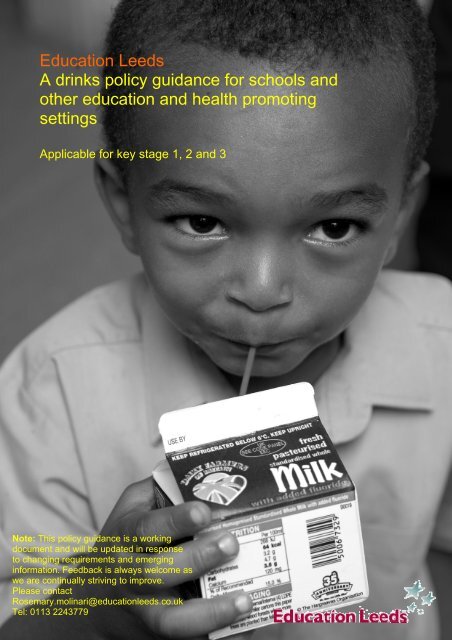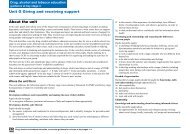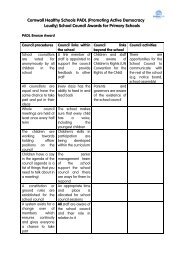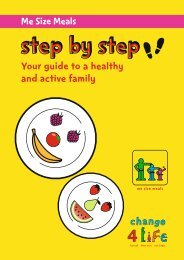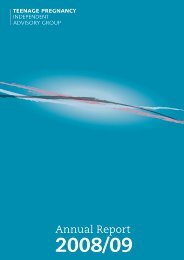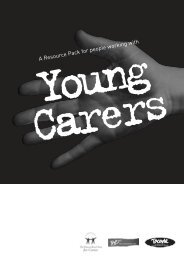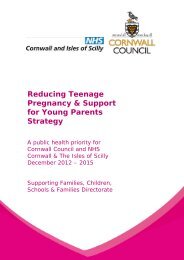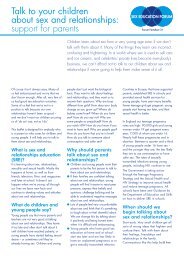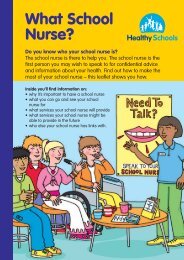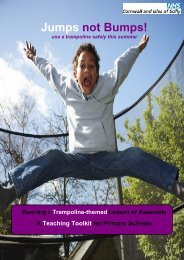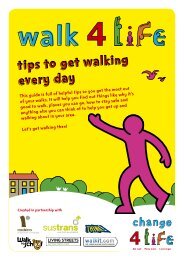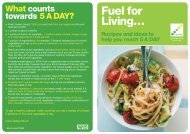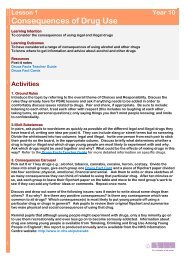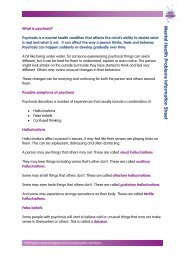School drinks policy guidance March 2010 - Cornwall Healthy Schools
School drinks policy guidance March 2010 - Cornwall Healthy Schools
School drinks policy guidance March 2010 - Cornwall Healthy Schools
You also want an ePaper? Increase the reach of your titles
YUMPU automatically turns print PDFs into web optimized ePapers that Google loves.
Education Leeds<br />
A <strong>drinks</strong> <strong>policy</strong> <strong>guidance</strong> for schools and<br />
other education and health promoting<br />
settings<br />
Applicable for key stage 1, 2 and 3<br />
Note: This <strong>policy</strong> <strong>guidance</strong> is a working<br />
document and will be updated in response<br />
to changing requirements and emerging<br />
information. Feedback is always welcome as<br />
we are continually striving to improve.<br />
Please contact<br />
Rosemary.molinari@educationleeds.co.uk<br />
Tel: 0113 2243779<br />
0
Contents<br />
Page<br />
Introduction 4<br />
Chapter 1: Policy context and frameworks<br />
1.1 Background<br />
- National standards for school food and drink<br />
- Leeds school meal strategy<br />
- National resources<br />
1.2 Health and education targets and inspections that should<br />
encourage schools to introduce a <strong>drinks</strong> <strong>policy</strong><br />
- National healthy schools programme<br />
5<br />
5<br />
5<br />
6<br />
6<br />
8<br />
8<br />
Chapter 2: Health<br />
2.1 Hydration<br />
- Calculating how much fluid a person should drink every day<br />
2.2 Water<br />
2.3 Combination Drinks<br />
2.4 The relationship between carbonated soft <strong>drinks</strong> and dental health<br />
2.5 The importance of calcium<br />
- Bone structures and osteoporosis<br />
2.6 Fluoride and the Leeds Fluoridated Milk Programme<br />
2.7 The importance of Vitamin C - Vitamin D and Iron<br />
2.8 Drinks, Nutrition and Health<br />
- Bladder and bowel problems<br />
2.9 <strong>Healthy</strong> eating model ‘eatwell’ plate<br />
2.10 Caffeine<br />
2.11 Glucose and sport nutrition<br />
- The Science<br />
2.12 General recommendations<br />
- Water recommendations for schools<br />
- Drinks for performance<br />
- Combination <strong>drinks</strong> recommendations for schools<br />
- Recommendations for individuals<br />
10<br />
10<br />
11<br />
11<br />
11<br />
12<br />
13<br />
13<br />
14<br />
15<br />
15<br />
14<br />
16<br />
16<br />
17<br />
17<br />
18<br />
18<br />
18<br />
18<br />
19<br />
2
- Hygiene recommendations for water bottles and cups 19<br />
Chapter 3: How to introduce and establish a <strong>drinks</strong> <strong>policy</strong><br />
Step 1 - Project Planning<br />
Step 2 - Carry out a <strong>drinks</strong> survey<br />
Step 3 - Discussion and contribution<br />
Step 4 - Develop a <strong>drinks</strong> <strong>policy</strong><br />
Step 5 - Marketing and promotion<br />
Step 6 - Monitoring and evaluation<br />
20<br />
20<br />
20<br />
20<br />
21<br />
21<br />
21<br />
Appendix<br />
1. Background 23<br />
2. Drinks permitted in schools (National Standards) 24<br />
3. Glossary of terms 26<br />
4. Case Studies 28<br />
5. Leeds Packed Lunch Policy 30<br />
6. Frequently Asked Questions 31<br />
7. Leeds catering providers 33<br />
8. Useful contact details and resources 35<br />
References 37<br />
Acknowledgements 39<br />
3
Introduction<br />
The main purpose of this <strong>drinks</strong> <strong>policy</strong> <strong>guidance</strong> is to provide Leeds schools<br />
with a comprehensive and simple guide to help inform and implement a<br />
school <strong>drinks</strong> <strong>policy</strong> as part of the healthy school programme. The content<br />
may also be useful for other education and health promoting settings e.g.<br />
Youth centres, and the workplace.<br />
The recommendations are aligned to the government’s national school food<br />
and <strong>drinks</strong> reforms, which provides a benchmark to promote parity and avoid<br />
mixed messages. The current <strong>drinks</strong> reform refers only to <strong>drinks</strong> sold in<br />
schools - there are no restrictions on the quality of <strong>drinks</strong> brought into school.<br />
This <strong>guidance</strong> aims to help pupils and families make an informed healthy<br />
choice.<br />
It provides detailed information and <strong>guidance</strong>, including background <strong>policy</strong><br />
context and offers teachers, families and health professionals a clear,<br />
evidence based understanding of how a good <strong>drinks</strong> <strong>policy</strong> can positively<br />
impact on children’s health and economic well being. The information also<br />
aims to help inform lesson plans, planning and class discussion.<br />
The <strong>guidance</strong> is structured into three core chapters;<br />
1. Chapter 1 examines <strong>policy</strong> and the national standards<br />
2. Chapter 2 examines the benefits of <strong>drinks</strong> <strong>policy</strong><br />
3. Chapter 3 provides a step by step guide on how a good <strong>drinks</strong> <strong>policy</strong><br />
can be implemented in schools.<br />
This content is designed to:<br />
• Examine the benefits of introducing a <strong>drinks</strong> <strong>policy</strong>.<br />
• Demonstrate the importance of hydration.<br />
• Explain which <strong>drinks</strong> are recommended.<br />
• Promote <strong>drinks</strong> are most likely to support good health and education<br />
outcomes.<br />
• Understanding why some <strong>drinks</strong> are removed e.g. carbonated <strong>drinks</strong>.<br />
• Provide an overview of dental health.<br />
• Introduce the Leeds Fluoridation Programme.<br />
• Provide contact details of all Leeds catering providers and their <strong>drinks</strong><br />
provision.<br />
• Make recommendations based on robust evidence.<br />
• A stepped guide to implement a sustainable school <strong>policy</strong>.<br />
The appendices section includes:<br />
1. Background of existing policies<br />
2. A table of <strong>drinks</strong> permitted in schools (national standards)<br />
3. Glossary of terms<br />
4. Local case studies<br />
5. Leeds packed lunch <strong>policy</strong> framework and toolkit<br />
6. Frequently asked questions<br />
4
7. List of <strong>drinks</strong> that Leeds catering providers offer and contact details<br />
8. Useful resources and local dental contacts.<br />
Chapter 1: Policy context and frameworks<br />
1.1 Background<br />
National standards for school food and drink<br />
In September 2005, the government introduced mandatory nutritional<br />
standards which saw the removal of food and <strong>drinks</strong> that were high in fat,<br />
sugar and salt from being sold in schools. The standards were also in place to<br />
try and promote the use of fresh ingredients, such as fruit.<br />
In September 2009, it became mandatory that all schools, pupil referral units,<br />
special inclusive learning environments and academies provide a school<br />
lunch that fits with the national standards. Therefore, all meals, food and<br />
<strong>drinks</strong> for the general school population must meet the standards from<br />
08.00hr to 18.00hr and include breakfast, tuck shops and all extended service<br />
activities.<br />
See appendix 1 for more detailed information.<br />
Leeds school meal strategy<br />
Education Leeds responded to the Government <strong>School</strong> Food Reform Bill and<br />
launched the Leeds school meal strategy to transform school food and<br />
increase school meal uptake. The strategy focuses on supporting the school<br />
and all Leeds catering providers to establish a sustainable school meals<br />
service and environment that meets the needs of children and young people.<br />
This <strong>drinks</strong> <strong>guidance</strong> forms a key action to implement the Leeds strategy to<br />
improve school food and drink.<br />
The Leeds school meals strategy<br />
http://www.educationleeds.co.uk/schoolmeals/infopa<br />
ge.aspx?pageno=659<br />
The Leeds packed lunch <strong>policy</strong> and toolkit forms an important action to<br />
increase school meal uptake. The <strong>policy</strong>’s guiding principles encourage<br />
schools to implement a ‘water only’ <strong>policy</strong>, or a <strong>drinks</strong> <strong>policy</strong> where all fizzy<br />
<strong>drinks</strong>, plus sugar free and diet <strong>drinks</strong> are all removed. Many Leeds schools<br />
have chosen to utilise this framework to implement a robust packed lunch<br />
<strong>policy</strong>. The Leeds <strong>policy</strong> aligned to the national school food based standards<br />
to promote parity and tackle food poverty. The <strong>policy</strong> was informed by public<br />
consultation involving hundreds of headteachers, governors, pupils and<br />
parents. The packed lunch <strong>policy</strong> includes a section on <strong>drinks</strong> see appendix 5.<br />
5
Leeds Packed Lunch Policy document,<br />
includes a framework to benchmark quality<br />
across the city and a range of pragmatic<br />
guiding principles.<br />
http://www.educationleeds.co.uk/schoolmeals/<br />
infopage.aspx?pageno=661<br />
Leeds Packed Lunch evidence based<br />
rationale document, it includes the findings<br />
from the pupil consultation and illustrates a<br />
duty of care that a packed lunch <strong>policy</strong> offers.<br />
http://www.educationleeds.co.uk/schoolmeals/<br />
infopage.aspx?pageno=661<br />
The Leeds packed lunch toolkit, includes a<br />
range of tools developed to help schools<br />
implement a robust and sustained <strong>policy</strong><br />
including surveys, letters to parents etc.<br />
http://www.educationleeds.co.uk/schoolmeals/<br />
infopage.aspx?pageno=661<br />
National school food and drink standard resources<br />
The Department for Children, <strong>School</strong>s and Families (DCSF) appointed The<br />
<strong>School</strong> Food Trust to develop the school food reform and relevant resource<br />
documents to support schools. These resources include the following four<br />
<strong>guidance</strong> documents which clearly states all <strong>drinks</strong> restrictions, which have<br />
been adopted to inform this schools <strong>drinks</strong> <strong>policy</strong> guide and can act as key<br />
reference documents to further inform your school <strong>drinks</strong> <strong>policy</strong>.<br />
The <strong>drinks</strong> standard was put into place to remove <strong>drinks</strong> from schools which<br />
have no nutritional value and can cause tooth decay in children. It aims to<br />
6
encourage children to drink water or <strong>drinks</strong> that provide other important<br />
nutrients (<strong>School</strong> Food Trust, 2007).<br />
The <strong>drinks</strong> that have been removed from schools due to these standards are<br />
sugary carbonated <strong>drinks</strong>, even the sugar free varieties have been removed.<br />
Other <strong>drinks</strong> that have been removed include sugary juices that did not<br />
comply with the standards and also <strong>drinks</strong> high in caffeine, and other high<br />
energy sugar <strong>drinks</strong>.<br />
Drinks that have been put into schools are milk/alternative <strong>drinks</strong> that contain<br />
more than 50% milk/alternative and also fruit and vegetable juices containing<br />
more than 50% juice (see appendix 2). Water is also more readily available to<br />
children in schools to help keep them hydrated (see page 10 for more<br />
information on hydration).<br />
1. The Food based and nutrient based standards<br />
<strong>guidance</strong> for school lunches.<br />
http://www.schoolfoodtrust.org.uk/document.asp<br />
2. A guide to the Government’s food based<br />
standards for school lunches.<br />
http://www.schoolfoodtrust.org.uk/document.asp<br />
3. A guide to the new food based standards for<br />
food other than lunches<br />
http://www.schoolfoodtrust.org.uk/document.asp<br />
7
4.A practical guide to adopting a whole school<br />
approach for those children on special diets and<br />
special schools.<br />
http://www.schoolfoodtrust.org.uk/doc_item.asp?<br />
DocCatId=9&DocId=101<br />
1.2 Health and education targets and inspections that should encourage<br />
schools to introduce a <strong>drinks</strong> <strong>policy</strong><br />
National healthy schools programme<br />
The national healthy schools programme aims to help schools to strive for<br />
lasting health and well-being behaviour changes in children and young<br />
people, with particular focus on providing targeted support for those who are<br />
most at risk. The outcomes will reflect school-based local and national<br />
priorities. <strong>Healthy</strong> eating is a core theme, which includes the following criteria:<br />
• 2.3 A Whole <strong>School</strong> Food Policy<br />
• 2.10 Easy access to water.<br />
The minimum evidence for criteria needed is to ensure that children, young<br />
people and staff say they have access to free, clean and palatable drinking<br />
water at lunchtime and throughout the day, and have been consulted about<br />
where it is located. The school is required to monitor availability of water<br />
consumption is encouraged and ensures it is being used by children and<br />
young people. It also states that schools should consider whether water<br />
stations are clean and welcoming? Is drinking water accessible at all times?<br />
Do children and young people use water bottles during lessons? Is the<br />
consumption of drinking water promoted throughout the day as well as at<br />
meal times?<br />
For more information go to: http://home.healthyschools.gov.uk/<br />
National <strong>Healthy</strong> <strong>School</strong>s Programme. Guidance<br />
for schools on healthy eating.<br />
http://resources.healthyschools.gov.uk/v/a46a61cb-<br />
75a0-4d90-8681-03ceddc619a2?c=8d58bfca-39d1-<br />
4d7d-927a-9cb501033fb9<br />
For local information go to:<br />
http://www.educationleeds.co.uk/<strong>School</strong>Meals/<br />
8
2009 National <strong>Healthy</strong> schools - Enhancement<br />
model.<br />
http://resources.healthyschools.gov.uk/s/Enhancem<br />
ent<br />
The national school food and drink standards are now included as a main<br />
judgement on pupil outcomes for Every Child Matters. Under the revised<br />
Ofsted inspection framework, assessment of a school’s performance on<br />
health and well-being is assessed by the extent to which pupils adopt<br />
healthy lifestyles as part of the evaluation criteria of healthy eating. Pupils<br />
choosing healthier <strong>drinks</strong> as part of the school’s food <strong>policy</strong> will provide this<br />
evidence.<br />
The inspection considers that this judgement also takes into consideration the<br />
school Governor’s role in ensuring the schools comply with the standards and<br />
assesses food and drink policies.<br />
Food Policy in <strong>School</strong>s: A Strategic Policy Framework for<br />
Governing Bodies may be accessed<br />
http://www.nga.org.uk/uploads/Food%20Policy%20Doc.p<br />
df<br />
For more information on Governors role and<br />
responsibility go to: www.nga.org.uk<br />
9
Chapter 2: Health<br />
This chapter explains the benefits to schools and other settings to<br />
implementing a drink <strong>policy</strong>. It provides a range of general facts and<br />
information to support the development of your school <strong>drinks</strong> <strong>policy</strong>. It also<br />
offers information why an individual should adopt healthier choices of fluids to<br />
achieve hydration.<br />
A school <strong>drinks</strong> <strong>policy</strong> should aim to encourage school children to choose<br />
healthy <strong>drinks</strong>, such as water and fluids that provide nutrients such as milk,<br />
yoghurt or dairy equivalent <strong>drinks</strong> as they address calcium requirements.<br />
Calcium is important to help bone and teeth growth. This <strong>policy</strong> <strong>guidance</strong> also<br />
aims to encourage consumption of fruit or vegetable juices that provide<br />
vitamin C and other necessary nutrients.<br />
The following sub-chapters provide general information to support your<br />
schools drink <strong>policy</strong> development, curriculum and school discussions:<br />
1. Hydration.<br />
2. Water.<br />
3. Combination <strong>drinks</strong>.<br />
4. The link between carbonated <strong>drinks</strong> and dental health.<br />
5. Importance of calcium.<br />
6. Leeds fluoridated milk programme.<br />
7. Importance of vitamin C, D and iron.<br />
8. Drinks, Nutrition and Health.<br />
9. <strong>Healthy</strong> eating model ‘eatwell’ plate.<br />
10. Caffeine.<br />
11. Glucose and sport nutrition.<br />
12. Recommendations.<br />
2.1 Hydration<br />
This section explains why hydration is important for individuals.<br />
Everyday we lose more than two litres of fluid through normal bodily functions<br />
by evaporation when we breathe and sweat, and as our bodies work they<br />
produce waste products. Fluid is also responsible for moving nutrients around<br />
the body and most of the chemical reactions within our cells take place in<br />
water. Our bodies are made of 70% water, with most of our organs and all of<br />
our cells counting on fluid to keep them working properly. Therefore, it is<br />
critical to ensure hydration is maintained. There are a variety of <strong>drinks</strong> that<br />
can help to achieve good hydration such as water, herbal teas and fruit and<br />
vegetable juices.<br />
Adequate hydration is a key factor towards improving the performance and<br />
behaviour of children at school. Children aged 11 and above, should be<br />
drinking approximately two litres of fluid a day. However, data from the<br />
National Diet and Nutrition Survey suggest that 40% of 11 - 18 year olds are<br />
consuming less than the recommended minimum of 1.2 litres per day (British<br />
Soft Drinks Association).<br />
10
The Food Standards Agency report 'Drinking in <strong>School</strong>s' by the Expert Group<br />
on Hydration found that schools that were taking steps to increase their pupils<br />
fluid intake had found the children were calmer, generally better behaved, had<br />
better concentration, fewer headaches and a reduction in lethargy.<br />
Dehydration effects can be serious and symptoms, such as headaches,<br />
digestive problems, lack of concentration and dry skin, can develop. These<br />
can have a knock-on effect on work, studies and even socialising. At school, it<br />
could potentially have a negative effect on quality of study and performance.<br />
(Expert Group on Hydration, 2005).<br />
Calculating how much fluid a person should drink every day to maintain<br />
hydration.<br />
An individual can roughly estimate the amount of liquid required each day as it<br />
can be calculated at 30ml per kilo of body weight.<br />
Here are some worked examples:<br />
1. Student weighs 10 kilos they will require 30ml x 30 kg* = 900ml of<br />
liquid per day.<br />
2. Student weighs 50 kilos, they will require 30ml x 50kg* = 1500ml of<br />
liquid per day.<br />
* this amount will increase with the intensity of time spent exercising.<br />
2.2 Water<br />
As discussed earlier, water is one of the best fluids to achieve good hydration.<br />
This section explains all you need to know for schools and individuals. It<br />
includes some recommendations for schools and individuals to help achieve<br />
good hydration throughout the day.<br />
Water makes up 80% of the brain so it's important that enough water is<br />
consumed in order to concentrate - especially in lessons at school. Everyone<br />
should try to regularly add to their water levels, particularly if it's a sports day<br />
or the weather is hot.<br />
The 2009 national standards that promote free water were introduced<br />
especially to help children switch to drinking water with meals instead of less<br />
healthy sweetened soft <strong>drinks</strong>. Water also promotes hydration and has no<br />
calories. Therefore, to promote access to good free tap water in schools<br />
ensures water is equally accessible to all.<br />
2.3 Combination Drinks<br />
As well as plain <strong>drinks</strong>, such as water or milk, schools are encouraged to<br />
provide or promote a combination of <strong>drinks</strong> in schools which positively support<br />
the nutritional health of children. The criteria for these <strong>drinks</strong> are that they:<br />
• Are unsweetened, unfortified and additive free.<br />
• Do not contain preservatives, flavourings, colourings and sweeteners.<br />
11
Combination Drinks (<strong>School</strong> Food Trust)<br />
Below is a list of combination <strong>drinks</strong> that are permitted in schools:<br />
• Combinations of water (still or carbonated) and fruit and/or vegetable juice<br />
<strong>drinks</strong> must contain at least 50% juice, no added sugar and may contain<br />
vitamins or minerals.<br />
• Combinations of milk (skimmed or semi-skimmed) or plain yoghurt, water,<br />
fruit or vegetable juice. In these combinations the milk or yoghurt must be<br />
at least 50% by volume, and the combined drink may contain vitamins and<br />
minerals. Less than 5% sugar or honey may be added to the milk or<br />
yoghurt components.<br />
• Combinations of plain soya, rice or oat drink, water, fruit or vegetable juice.<br />
In these combinations the soya, rice or oat drink must be at least 50% by<br />
volume, and the combined drink may contain vitamins and minerals. Less<br />
than 5% sugar or honey may be added to the soya, rice or oat component.<br />
• Combinations of milk (skimmed or semi-skimmed), plain yoghurt or plain<br />
soya, rice or oat <strong>drinks</strong> (with or without plain water) with cocoa. In these<br />
combinations the milk, yoghurt, soya, rice or oat drink must be at least<br />
50% by volume and the combined drink may contain vitamins and<br />
minerals. Less than 5% sugar or honey may be added to the milk, yoghurt,<br />
soya, rice or oat component. No colourings are permitted.<br />
2.4 Carbonated soft <strong>drinks</strong> and dental health?<br />
It is estimated that between 52% and 77% of children aged 8 to 15 years have<br />
some obvious tooth decay in their permanent teeth (NHS, 2008). The<br />
evidence shows that more than 5,560 million litres of carbonated soft <strong>drinks</strong><br />
are consumed every year in the UK, many of which are high in sugar, both<br />
and acids that attack teeth and lead to tooth decay.<br />
Tooth decay happens in two ways when teeth are attacked by acid and sugar.<br />
Acid attacks can happen as a result of plaque bacteria acting on the sugars in<br />
our diet, or as a direct result of the acids in food dissolving away the enamel<br />
on the surfaces of our teeth. As carbonated soft <strong>drinks</strong> tend to contain high<br />
amounts of both acids (often the sugar free brands), and sugars are the worst<br />
possible combination for dental health.<br />
Even <strong>drinks</strong> labelled 'sugar free’ can still cause damage to teeth as they have<br />
the same acids as the standard carbonated <strong>drinks</strong>. Therefore, it is<br />
recommended that carbonated <strong>drinks</strong> in the diet are replaced with alternative<br />
options. Sugary and acid <strong>drinks</strong>, if consumed, are best consumed at meal<br />
times, this is because the saliva produced to digest food also protects the<br />
teeth.<br />
The main cause of tooth decay is not the amount of sugar or acid in the diet,<br />
but how often it is consumed. The more often a child has sugary or acidic<br />
foods or <strong>drinks</strong>, the more likely they are to have decay, especially if consumed<br />
12
etween meals in the absence of saliva being produced. (British Dental<br />
Health Foundation, 2005).<br />
Importance of Vitamins and Minerals in healthy <strong>drinks</strong><br />
Drinks can provide a range of important nutrients to help growth and repair<br />
and give energy. The following sub-chapters include basic information on a<br />
few core nutrients that will benefit learning, health and energy.<br />
2.5 The importance of Calcium<br />
Calcium is very important for growing children and young people, as it helps<br />
build healthy bones and teeth. Milk and other dairy products are the richest<br />
sources of calcium and should be consumed every day. They also contain<br />
other valuable vitamins and minerals, as well as protein.<br />
Children and young people that are lactose intolerant can get calcium from<br />
Soya, rice or oat <strong>drinks</strong> that have been fortified with calcium.<br />
Bone structures and osteoporosis<br />
Our skeleton will provide a solid framework for life but it needs tender loving<br />
care just like our skin, hair or heart. There are many steps you can take to<br />
help build healthy bones, which are all linked to leading a healthy lifestyle.<br />
Your skeleton grows stronger if you do regular weight-bearing exercise. This<br />
is any kind of physical activity where you are supporting the weight of your<br />
own body, for example jogging, aerobics, tennis, dancing and brisk walking.<br />
Moderate weight lifting is another good type of bone-building exercise, where<br />
the action of the tendons pulling on the bones to boost bone strength.<br />
During teenage years we should achieve what is known as ‘peak bone mass’,<br />
this is achieved by healthy lifestyles including healthy diet, exercise and<br />
consuming at least half a pint of milk every day to meet calcium requirements.<br />
We continue to strengthen our bones until approximately 30 years of age.<br />
After which it is important to maintain our peak bone mass, this is achieved by<br />
healthy eating and regular exercise (of course).<br />
Although the body contains 1kg of calcium, 99% of which is stored in our<br />
bones, and helps build strong bones, it also requires many other nutrients.<br />
Therefore, it is important to promote a wide variety of food to make sure a mix<br />
of all the vitamins and minerals needed are eaten as illustrated by the national<br />
Eatwell plate.<br />
13
This is how a healthy bone structure looks<br />
like this under a microscope. The diagram<br />
illustrates a strong dense bone structure.<br />
Weight bearing exercise triggers the body to<br />
make more bone structures to strengthen the<br />
bone for life.<br />
This is how an unhealthy bone structure<br />
looks like this under a microscope. This<br />
diagram illustrates a fragile bone structure<br />
and helps to demonstrate how easily a bone<br />
can be broken.<br />
This condition is called osteoporosis. Further<br />
information on osteoporosis can be found at:<br />
https://www.nos.org.uk<br />
2.6. Fluoride and the Leeds Fluoridated Milk Programme<br />
Fluoride is probably the most effective treatment available for both preventing<br />
and limiting the spread of tooth decay. The Leeds Fluoridated Milk Project<br />
aims to encourage schools to supply milk with added fluoride to help protect<br />
children’s teeth. The project lead is Denise Creasey - Project Co-ordinator,<br />
see appendix 8 for details.<br />
Fluoride can have a very positive effect on dental health as it strengthens<br />
tooth enamel, making it more resistant to tooth decay. It also reduces the<br />
amount of acid that the bacteria on teeth produce.<br />
Children with developing teeth who have fluoride tend to have shallower<br />
grooves in their teeth so plaque can be removed more easily. Adding fluoride<br />
to <strong>drinks</strong> has been researched for over 50 years and the addition of fluoride to<br />
<strong>drinks</strong> has been proven to reduce tooth decay by 40 - 60% (British Dental<br />
Health Foundation, 2005).<br />
14
2.7 The importance of Vitamin C - Vitamin D and Iron<br />
Vitamins and minerals often act together in the body to promote good health.<br />
Vitamin C for instance has two important functions:<br />
1. Helps protect cells and keeps them healthy, and<br />
2. Helps the body absorb iron from food.<br />
Citrus fruits (such as oranges and lemons) and berries (strawberries and<br />
blackcurrants) are all good sources of vitamin C. Vitamin C will help the body<br />
absorb iron, so it's a good idea to have fruit juice with an iron-rich meal, this<br />
includes cereals fortified with iron.<br />
Iron is an important mineral as it helps to make red blood cells, which carry<br />
oxygen around the body in haemoglobin. This will enhance children and<br />
young people’s performance in both mental and physical performance.<br />
To help absorb calcium from food and <strong>drinks</strong>, it is important to get enough<br />
vitamin D. Vitamin D comes mainly from sunlight and from foods such as<br />
margarines and spreads, breakfast cereals and oily fish. The main source is<br />
sunlight absorbed through our skin, which the body converts into vitamin D<br />
and stores in our body fat. In a fair skinned person, 20 - 30 minutes of sunlight<br />
exposure two or three times a week, on the face and forearms at midday is<br />
sufficient to achieve healthy vitamin D levels in summer in the UK. For<br />
individuals with pigmented skin and the elderly, exposure time or frequency<br />
needs increasing slightly (British Medical Journal, <strong>2010</strong>). Our bodies store<br />
Vitamin D in the liver during the winter months for the deficit post October.<br />
The body uses and stores vitamin D throughout the year.<br />
There are however, a few risk groups that are unable to absorb the right<br />
amount of sunlight needed. Skin colour has an impact, the darker the colour<br />
of the skin, the more difficult it is to absorb light from the sun (Public Radio<br />
International, 2008), and so it is important that it is provided in the diet (from<br />
margarine, oily fish, eggs). Religious beliefs and age can also have affect;<br />
infants and the elderly are most susceptible to vitamin D deficiency (The<br />
Medical Algorithms Project, 2009). Some religions/cultures require wearing<br />
clothing that covers the full body when outdoors, making these groups at risk<br />
as they are unable to get the sufficient sunlight needed and must get vitamin<br />
D from the diet.<br />
2.8 Bladder and bowel problems<br />
About 1 in 12 young people in the UK struggle with bedwetting, daytime<br />
wetting, constipation and soiling (Education and Resources for Improving<br />
Childhood Continence – ERIC).<br />
ERIC offer an extensive range of resources and <strong>guidance</strong> on childhood<br />
continence. There are many causes of bladder problems. One of the main<br />
causes is drinking too many fizzy <strong>drinks</strong>, and not enough natural water. This<br />
can irritate the bladder and worsen the problem, such as bed wetting and day<br />
15
wetting. Swapping to plain water and fruit juices will help, and promote small<br />
amounts through the day- reducing fluids towards bed time. (Incontact, 1999)<br />
2.9 <strong>Healthy</strong> eating model ‘eatwell’ plate<br />
Advice on a healthy balanced diet is demonstrated in ‘the eatwell plate’ which<br />
can be found at the following link:<br />
The Eatwell plate (replaces the<br />
Balance of Good health model)<br />
For more information go to<br />
www.eatwell.gov.uk/healthydiet/eat<br />
wellplate/<br />
2.10 Caffeine<br />
Diuretics and Caffeine<br />
Children are being exposed to caffeine from soft <strong>drinks</strong>, coffee, tea, energy<br />
<strong>drinks</strong>, ice cream, caffeinated water and chocolate on a daily basis. Caffeine<br />
is a diuretic; diuretics allow an increased flow of urine and aid the removal of<br />
fluids from the body. While natural diuretics aid removal of excess fluids from<br />
the body, it may also mean loss of important vitamins and minerals too.<br />
Diuretics cause your kidneys to pull more water out of your bloodstream even<br />
as the digestive system is pulling water into your body. It's a two-stepsforward-one-step-back<br />
scenario. If you add milk or sugar, then you reduce the<br />
rate of water absorption even further. Too much caffeine therefore can lead to<br />
a loss of important nutrients.<br />
The effect of caffeine on children's moods and behaviour is a growing cause<br />
for concern. In a study done by the National Institute of Mental Health, 8-13<br />
year olds who regularly consumed high doses of caffeine were judged to be<br />
more restless by teachers, and one-third were hyperactive enough to meet<br />
the criteria for attention deficit disorder with hyperactivity (MedicineNet, 2007).<br />
A Stanford study (USA) found that children who were consumers of caffeine,<br />
and were then deprived of daily caffeine reported having symptoms including<br />
16
trouble thinking clearly, not feeling energetic, and getting angry. The research<br />
in this area is somewhat limited, but the studies that have been conducted are<br />
compelling enough to warrant restricting caffeine intake in children to as little<br />
as possible. If there is no need for caffeine, why take the risk and allow<br />
children to consume it? (MedicineNet, 2007).<br />
Due to the evidence found on the effects of caffeinated <strong>drinks</strong> on children and<br />
young people’s behaviour, some schools have decided to remove <strong>drinks</strong><br />
containing caffeine like red bull and other fizzy <strong>drinks</strong>. In appendix 4, you can<br />
see a case study from Morley High <strong>School</strong> in Leeds where they decided to<br />
remove caffeine containing <strong>drinks</strong> from the school.<br />
2.11 Glucose and sport nutrition<br />
Glucose is a sugar that is found in many <strong>drinks</strong>, many of which are restricted<br />
through the national <strong>guidance</strong>. However it is important to understand the role<br />
of glucose in exercise.<br />
The body uses glucose in the blood during exercise. The <strong>drinks</strong> industry have<br />
developed a vast range of sport <strong>drinks</strong>. Where sport performance is<br />
concerned it is often not just the amount you drink but when you drink it.<br />
These <strong>drinks</strong> are valuable both before (within 2 hours), during, and after<br />
exercising. Understanding how much you should drink and when, will help<br />
improve performance. This is especially important for students who are taking<br />
part in exercise after school and have not eaten or taken in any sugars within<br />
two hours of the planned exercise session e.g. football, hockey, rugby, etc.<br />
The science behind nutrition and sport performance is very complex. This<br />
sections offers basic information to highlight the importance of nutrition and<br />
sport performance. Often students who do participate in after school activity<br />
are more likely to respond to information about healthy eating behaviour to<br />
improve their performance and prevent injury and maintain energy to<br />
concentrate in sport and study. Therefore it is an important aspect to consider<br />
this section in your school food and <strong>drinks</strong> <strong>policy</strong>, school planning,<br />
consultation and class discussion groups<br />
The science<br />
When you exercise, your body responds to the activity by releasing hormones<br />
that cause your body to increase blood glucose levels. This occurs through a<br />
process called gluconeogenesis or glycogenesis that takes place in the liver.<br />
Excessive glucose that has been previously digested and converted and<br />
stored in the liver as glycogen is converted back to glucose and sent to the<br />
muscles during exercise. In the muscles, the glucose is broken down to yield<br />
energy which is the fuel source for muscles.<br />
It is important to have some glucose readily available in the blood before<br />
exercising and to stock up on glucose after exercising; as exercise demands<br />
more energy and that energy comes from your blood glucose. Following your<br />
workout, your blood glucose level remains low as the body rebuilds its<br />
17
glucose reserves in the liver. Therefore it is important to replace the depleted<br />
stores of glucose in the liver and the muscles. This can be done easily by<br />
eating a healthy meal with carbohydrates within 2 hours of exercising (this is<br />
the preferred option), or if a healthy meal is not available within the 2 hour<br />
period after exercise it is recommended to eat a glucose snack e.g. 50grams<br />
of carbohydrate e.g. two large bananas<br />
Ideally the healthy food is the preferred option as it also provides the tired<br />
muscles with important nutrients that help to repair and strengthen muscles<br />
ready for the next time you exercise.<br />
The recommended amount of<br />
glucose is usually calculated at 5%<br />
strength.<br />
This equates to just 5 grams of<br />
glucose to every 100mls of water.<br />
Note: - Sport <strong>drinks</strong> are often 10%<br />
strength - these can be diluted down<br />
with water by 50% (half)<br />
2.12 General recommendations and guiding principles for hydration<br />
Water recommendations for schools<br />
1. Make sure that water is available, easily accessible and is free of<br />
charge to all pupils where they are having lunch.<br />
2. Signpost water stations in the dining room.<br />
3. Give younger children a cup or glass of water or let them carry water<br />
bottles.<br />
4. Dining room supervisors should direct children to water sources.<br />
5. Promote water availability throughout the school, so children do not<br />
have to rely on taps in toilets for a drink.<br />
Nutrition and sport<br />
1. Make sure pupils have access to adequate water before during and<br />
after exercise.<br />
2. Consuming carbohydrates before and during exercise will help,<br />
however, this does not necessarily need to be sport <strong>drinks</strong> – it can be<br />
just two bananas.<br />
3. A school food <strong>policy</strong> should consider access to appropriate food and<br />
drink to support energy requirements especially sport colleges, and<br />
after school activities.<br />
18
4. Pupils should be encouraged to eat a healthy meal containing<br />
carbohydrates and protein and important nutrients (not <strong>drinks</strong>) within 2<br />
hours of finishing rigorous exercise e.g. chicken pasta with vegetables<br />
Combination <strong>drinks</strong> recommendations for schools<br />
1. Combine a variety of fruit juices, for example apple, orange, pineapple<br />
or mixed juices.<br />
2. Include smoothies made from yoghurt and/or milk combined with fruit<br />
or fruit juice using a variety of fruits to introduce children to new<br />
flavours. Let the children watch and learn how to make smoothies as it<br />
can also help them to achieve their 5 A DAY.<br />
3. Your catering provider, or if you are a school that provides in-house<br />
catering is obliged to provide access to free drinking water in order to<br />
comply with the national standards. This could include the provision of<br />
freshly-poured tap water together with cups on tables and at the<br />
serving counter.<br />
4. Consider installing a point-of use water cooler which uses mains water.<br />
5. Modern water fountains could be an additional water point in the dining<br />
room.<br />
6. Implement <strong>drinks</strong> <strong>policy</strong> that reflects the national standards.<br />
7. Implement <strong>policy</strong> that restricts drink brought into school that are high in<br />
caffeine.<br />
Recommendations for individuals<br />
1. Avoid sugary, or acidic <strong>drinks</strong>, or sugar free <strong>drinks</strong> between meals -<br />
water or milk are the best options.<br />
2. Leave a gap of one to two hours each time you eat or drink to allow for<br />
remineralisation to occur.<br />
3. Consume only water after you have brushed your teeth at night; less<br />
saliva is produced at night.<br />
4. Do not brush your teeth immediately after eating acidic foods or <strong>drinks</strong>.<br />
If teeth are brushed when in a demineralised state, a layer of tooth<br />
enamel may also be removed (BBC, 2008).<br />
5. Sugar free chewing gum produces more saliva, which cancels out the<br />
acid after food/ drink. Chewing gum containing Xylitol may help to<br />
reduce tooth decay. (British Dental Health Foundation, 2005).<br />
Hygiene recommendations for water bottles and cups<br />
1. Where bottles are being used for water only and single use (not shared<br />
– only one per person), they can be washed once a week (where not<br />
soiled).<br />
2. Where bottles are used for juice of any description they should always<br />
be washed afterwards – the same as a cup would be washed after<br />
every use.<br />
3. Where water is being dispensed ion a cup it should be treated the<br />
same as a fork/knife/spoon and should be washed after every use.<br />
19
Chapter 3: How to introduce and establish a healthy <strong>drinks</strong> <strong>policy</strong><br />
This section offers a step-by-step guide to creating a <strong>drinks</strong> <strong>policy</strong> in your<br />
school.<br />
Step 1<br />
Project<br />
Planning<br />
Choose a lead person and set up a group of pupils and/or staff to<br />
work on creating a <strong>drinks</strong> <strong>policy</strong>. Ask the school council to look at this<br />
topic as part of their school packed lunch <strong>policy</strong> work group.<br />
Step 2<br />
Carry out a<br />
<strong>drinks</strong> survey<br />
To gather information about the current <strong>drinks</strong> being sold/brought<br />
into schools the group of pupils/staff or school council should carry<br />
out a survey. The results can be used to help decide the final <strong>drinks</strong><br />
<strong>policy</strong>. The survey can be conducted by pupils from the school<br />
council through questionnaires and / or observations.<br />
Once the findings will inform the outcome and analysis can be<br />
conducted in maths or IT lessons. The impact can be considered /<br />
discussed in Personal Social Health Citizenship Education (PSHCE)<br />
to improve healthy eating.<br />
Step 3<br />
Discussion and<br />
contribution (all<br />
stakeholders)<br />
To encourage the types of <strong>drinks</strong> sold/brought into schools, both<br />
parents and pupils need to be onboard with any changes that are<br />
being made within the school.<br />
Consultation is a very important part of bringing about change. A<br />
good consultation exercise will:<br />
• Offer the chance to explain what the school/centres want to<br />
achieve and why.<br />
• Gain a greater understanding of the needs of children and young<br />
people and families<br />
• Allow children and young people and families to recognise that<br />
their views are valued, which will result in more confidence and<br />
compliance with the <strong>policy</strong><br />
• Encourage parents and pupils to get involved in their school<br />
community.<br />
Discussions can be carried out by a variety of groups within<br />
your school such as the healthy schools forum and pupil school<br />
council. The <strong>drinks</strong> <strong>policy</strong> should be included / promoted - parents<br />
evenings / health events / Sports days / After school when parents<br />
are waiting to collect their children.<br />
Note: Self-catering schools need to ensure <strong>drinks</strong> are aligned to the<br />
standards and avoid mixed messages with <strong>drinks</strong> <strong>policy</strong>.<br />
20
Step 4<br />
Develop a<br />
<strong>drinks</strong> <strong>policy</strong><br />
Step 5<br />
Marketing and<br />
promotion<br />
Step 6<br />
Monitoring and<br />
evaluation<br />
The next step is for the group of pupils/staff that were selected to<br />
work on the <strong>drinks</strong> <strong>policy</strong>, to use the information collected from<br />
surveys and discussions to create a <strong>policy</strong> that meets the needs of<br />
the school. The <strong>policy</strong> should be aligned to the national standards<br />
explained in this document (appendix 2).<br />
Market and promote your <strong>drinks</strong> <strong>policy</strong> through schools newsletters /<br />
letters home/ web site / twitter etc.<br />
Gradual changes; When creating a <strong>drinks</strong> <strong>policy</strong>, it is important that<br />
all families feel supported and encouraged to make positive, gradual<br />
changes. Any changes made to the types of <strong>drinks</strong> which can be<br />
brought into school should be made slowly.<br />
It is important that you build in time to monitor and evaluate how<br />
successful your <strong>drinks</strong> <strong>policy</strong> has been. Encourage the pupil/staff<br />
group to talk about how you feel it would be best to keep an eye on<br />
your <strong>drinks</strong> <strong>policy</strong>. Pupils need to be fully-involved in this. Make sure<br />
pupils can develop creative ways to track progress and help to keep<br />
up the momentum.<br />
Monitoring can simply be a gentle reminder of the schools health<br />
ethos – not control and command policing. The health culture will be<br />
influenced and behaviour change will occur gradually. In a secondary<br />
school it could take up to 5 years for the <strong>drinks</strong> <strong>policy</strong> to be fully<br />
embedded. Be prepared to be patient and to persevere with your<br />
health messages and mutual benefits.<br />
21
Appendices<br />
Section<br />
22
Appendix 1: Background<br />
National standards for school food and drink<br />
In September 2005 the government introduced mandatory nutritional<br />
standards, which are set out in the Education Nutritional Standards for <strong>School</strong><br />
Lunches (England) Regulations 2000 (SI 2000/1777) <strong>School</strong> Standards and<br />
Framework Act 1998: Section 114. The standards removed foods and <strong>drinks</strong><br />
that are high in fat, sugar and salt from being sold in schools, and aimed to<br />
promote the use of fresh ingredients.<br />
The transformation of school food and drink has become a central plank in the<br />
Department of Children <strong>School</strong>s and Families (DCSF) wider portfolio to<br />
improve the health and wellbeing of pupils to ensure their readiness to learn.<br />
The standards contribute directly to achievement of the ‘Be <strong>Healthy</strong>' Every<br />
Child Matters outcome and the Government's Public Service Agreement<br />
(PSA) target on child obesity. Its importance is further recognised by the<br />
inclusion of ‘school lunch take-up' as an indicator for the child health PSA and<br />
National Indicator Set; and by its place as one of four components of the joint<br />
DCSF/DH <strong>Healthy</strong> <strong>School</strong>s Programme.<br />
The 21 st Century <strong>School</strong>s White Paper proposed as part of the pupil<br />
guarantee that every pupil goes to a <strong>Healthy</strong> <strong>School</strong> that promotes healthy<br />
eating, an active lifestyle and emotional health and well-being. The DCSF<br />
recognise eating a healthy school lunch (which includes <strong>drinks</strong>) as a key part<br />
of meeting that guarantee. In September 2009, it became mandatory that all<br />
schools, including academies, provide a school lunch that conforms to the<br />
national standards. Therefore, all meals, food and <strong>drinks</strong> for the general<br />
school population must meet the standards from 08.00hr to 18.00hr and<br />
include breakfast, tuck shops and all extended service activities.<br />
Tackling obesity is a key national priority. This can be seen by its prominence<br />
in the Public Health White Paper: 'Choosing Health' (2004) and the<br />
introduction of National Institute of Health an Clinical Excellence (NICE)<br />
<strong>guidance</strong>. More recently, the '<strong>Healthy</strong> Weight, <strong>Healthy</strong> Lives' crossgovernment<br />
strategy has been developed. This aims to promote and support<br />
the adoption of the healthier lifestyle choices required to reduce obesity,<br />
especially among children.<br />
For more information go to:<br />
Department of Children <strong>School</strong>s and Families (DCSF)<br />
http://www.dcsf.gov.uk/<br />
23
Appendix 2: Drinks permitted in schools according to the national<br />
standards<br />
Drink<br />
category<br />
Description<br />
Volume<br />
Preservatives<br />
Antioxidants<br />
(added to prevent<br />
oxidation/<br />
discolouration)<br />
Stabilisers<br />
Water (still or Water<br />
carbonated) (unsweetened,<br />
unflavoured)<br />
Milk skimmed Skimmed or<br />
or semi- semiskimmed)<br />
skimmed milk<br />
(unsweetened,<br />
unflavoured)<br />
Fruit Juice Fruit juice<br />
(unsweetened/<br />
not fortified)<br />
Fruit juice<br />
from<br />
concentrate<br />
(unsweetened/<br />
not fortified)<br />
100%<br />
water<br />
No No No<br />
100% milk No No No<br />
100% fruit<br />
juice<br />
No<br />
Yes as permitted in<br />
Schedule 7 SI 1995<br />
No. 3187 The<br />
Miscellaneous<br />
Food Additives<br />
Regulations 1995†<br />
detailed below:<br />
All fruit juices:<br />
E300 ascorbic acid<br />
E330 citric acid;<br />
Pineapple juice:<br />
E296 malic acid<br />
Yes as permitted<br />
in Schedule 7 SI<br />
1995 No. 3187<br />
The<br />
Miscellaneous<br />
Food Additives<br />
Regulations 1995<br />
detailed below:<br />
Passion Fruit<br />
juice<br />
Pineapple juice:<br />
E440 Pectins<br />
Vegetable<br />
juice<br />
Plain<br />
(unsweetened,<br />
unflavoured)<br />
soya, rice or<br />
oat drink<br />
Vegetable<br />
juice or<br />
Vegetable<br />
juice from<br />
concentrate<br />
Plain<br />
(unsweetened,<br />
unflavoured)<br />
soya, rice or<br />
oat drink,<br />
enriched with<br />
calcium<br />
100%<br />
vegetable<br />
juice<br />
No<br />
regulation<br />
Grape juice:<br />
E170 calcium<br />
carbonate and<br />
E336 potassium<br />
tartrates<br />
No No No<br />
No No No<br />
24
Drink<br />
category<br />
Water (still or<br />
carbonated)<br />
Flavourings<br />
Colourings<br />
Others Sugars or honey<br />
(Added for the<br />
purpose<br />
of<br />
sweetening)<br />
Artificial<br />
sweeteners<br />
No No No No No No<br />
Fortificants<br />
(Added<br />
minerals and<br />
vitamins for<br />
the purpose<br />
of<br />
fortification<br />
Milk skimmed No No No No No No<br />
or semiskimmed)<br />
Fruit Juice No No Yes as permitted No<br />
No No<br />
in Schedule 3 SI<br />
1995 No. 3187 Note: As permitted in<br />
The<br />
Schedule 3 paragraph<br />
Miscellaneous 3 (a) 2003 SI No.<br />
Food Additives 1564 The Fruit Juices<br />
Regulations 1995 and Fruit Nectars<br />
detailed below: (England) Regulations<br />
2003 Sugar may be<br />
Pineapple Juice: added for the purpose<br />
E900 dimethylpolysiloxane<br />
of regulating acidic<br />
taste, in an amount<br />
(expressed as dry<br />
matter) not exceeding<br />
15g per litre of the<br />
juice in fruit juice,<br />
other than any<br />
prepared from grapes<br />
or pears<br />
Vegetable<br />
juice<br />
No No No No No No<br />
Plain<br />
(unsweetened,<br />
unflavoured)<br />
soya, rice or<br />
oat drink<br />
No No No No No Yes<br />
(Calcium)<br />
Table 1: List and definition of <strong>drinks</strong> permitted in schools<br />
(Source <strong>School</strong> Food Trust guide for standards document 2 above)<br />
25
Appendix 3: Glossary of Terms<br />
Absorption<br />
Antioxidant<br />
A process in which one substance filters through<br />
another.<br />
Chemical substances found in nature. They are a group<br />
of vitamins, such as vitamin C, vitamin E, vitamin A, etc.<br />
Attention<br />
disorder<br />
Caffeine<br />
deficit<br />
A childhood syndrome characterised by a short attention<br />
span, often accompanied by hyperactivity and disruptive<br />
behaviour.<br />
A naturally occurring chemical compound found in tea,<br />
coffee and fizzy <strong>drinks</strong> that act as a stimulant and a<br />
diuretic.<br />
Carbonated<br />
Combination<br />
Drinks<br />
Dehydration<br />
Demineralised<br />
Dental Caries<br />
Diuretic<br />
Electrolytes<br />
Enamel<br />
Evaporation<br />
Adding carbon dioxide gas into water/fluid to produce<br />
‘fizzy <strong>drinks</strong>’.<br />
Drinks that are mixed with another to create a nonalcoholic<br />
flavoured drink.<br />
The loss of water and salts essential for normal body<br />
function.<br />
The loss of minerals from teeth.<br />
Soft decayed area in a tooth; progressive decay can lead<br />
to the loss of a tooth.<br />
Promotes the formation of urine by the kidney.<br />
Chemicals such as salts and minerals needed for various<br />
functions in the body.<br />
The hard outer coating of a tooth.<br />
The conversion of a liquid to the vapour state (usually by<br />
heat).<br />
Gluconeogenesis The conversion of glycogen to glucose in the liver.<br />
Glycogenesis<br />
Hormones<br />
Hydration<br />
The conversion of glucose to glycogen.<br />
Chemical substances created by the body that control<br />
many body functions.<br />
To supply water to a person in order to restore or<br />
maintain fluid balance.<br />
26
Hyperactivity<br />
Nutrient<br />
Osteoporosis<br />
Peak bone mass<br />
Plain Drinks<br />
Plaque<br />
Preservatives<br />
Remineralisation<br />
Sugar Free<br />
Unfortified<br />
Unsweetened<br />
Xylitol<br />
Having highly or excessively active behaviour.<br />
A chemical factor that is needed for the growth and<br />
survival of an organism.<br />
Disease of the bone that leads to an increased risk of<br />
fracture.<br />
Point at which bones reach their maximum strength and<br />
density.<br />
Pure <strong>drinks</strong>, such as water, milk and 100% fruit juice.<br />
A sticky, colourless film of bacteria and sugars that<br />
constantly forms on our teeth.<br />
Used to help keep food for longer.<br />
The addition of minerals to a tooth to replace minerals<br />
lost.<br />
No added sugar.<br />
No additional ingredients added.<br />
No added sugar or sweeteners.<br />
A naturally occurring sweetener that does not cause<br />
tooth decay.<br />
27
Appendix 4: Case Studies<br />
Morley High <strong>School</strong>, Leeds<br />
Morley High <strong>School</strong> in Leeds is one of the schools that have implemented a<br />
<strong>drinks</strong> <strong>policy</strong> where caffeine containing <strong>drinks</strong> have been removed from the<br />
school. Caffeinated <strong>drinks</strong>, such as red bull – which has a very high caffeine<br />
content, and fizzy <strong>drinks</strong> have been removed and are not sold to pupils in<br />
school and pupils are not allowed to bring them in. Morley have chosen to sell<br />
only pure fruit juice and water to pupils instead.<br />
The school is aware that it will take some time for the <strong>drinks</strong> <strong>policy</strong> to be<br />
followed completely, as pupils do bring their own <strong>drinks</strong> in, but the <strong>policy</strong> has<br />
not been implemented by control and command – it is there to create a<br />
gradual shift and hopefully influence the pupil’s attitudes and behaviour<br />
towards the school’s health ethos. New pupils entering the school and parents<br />
are informed of schools expectations and <strong>drinks</strong> <strong>policy</strong>.<br />
Bankside Primary <strong>School</strong>, Leeds<br />
Pupils completed an application form and interview for the role of ‘Happy<br />
Lunchtime Helpers’. They encouraged other pupils to drink water (giving<br />
stickers to those that drank enough), as well as overseeing the dinner queues<br />
and praising healthy packed lunches.<br />
Water awareness promotion: Classes debated how to raise awareness of<br />
drinking water but avoid potential water fights with bottles. Resultantly, pupils<br />
will apply in writing and interview for roles with the Pupil Forum as ‘Quench<br />
Busters’ (water monitors).<br />
Boston Spa <strong>School</strong>, Leeds<br />
Boston Spa <strong>School</strong> has never sold common vending items in the main school<br />
(fizzy <strong>drinks</strong>, crisps and confectionery). When they decided to introduce<br />
vending over seven years ago, the focus was on providing children with<br />
alternatives to fizzy <strong>drinks</strong>. So they installed machines selling bottled water.<br />
The demand for vending grew, so Boston Spa worked with their vending<br />
operator and a local dietician who set strict nutrient standards for food and<br />
<strong>drinks</strong>, including levels of fat, sugar and salt, to provide a list of <strong>drinks</strong> and<br />
snacks. All products were initially taste trialled by the student council, who<br />
regularly discuss the school’s food and drink provision, and they loved all of<br />
them. Vending has continued to expand and take up is excellent- the school<br />
have seven bottled water machines and also five water fountains.<br />
Swinnow Primary, Leeds<br />
Swinnow primary school based in Leeds, carry out general observations of<br />
children’s packed lunches. Children are required to report to staff if another<br />
28
child brings a fizzy drink in. Staff at this school claim that it is going very well<br />
as only one parent has complained about this <strong>policy</strong> throughout the years.<br />
Staff at this school also said that healthy alternative <strong>drinks</strong> are always<br />
available and that the children do not miss fizzy <strong>drinks</strong>. This <strong>policy</strong> is also<br />
stated in the school’s prospectus.<br />
29
Appendix 5: Leeds Packed Lunch Policy ‘At A Glance’ This framework is<br />
taken from the Leeds packed lunch <strong>policy</strong> document.<br />
30
Appendix 6: Frequently Asked Questions<br />
How much water/fluid should children drink a day?<br />
The standard recommendation is at least 6-8 glasses (1.5-2 litres) of<br />
water/fluid should be drunk regularly throughout the day, and at least 3-4<br />
glasses should be drunk while at school. Children also need to ensure that<br />
they are getting plenty of additional fluid during warm weather and/or when<br />
exercising.<br />
What percentage of fluid deficiency triggers a decline in a pupil’s ability<br />
to concentrate?<br />
Just 1 - 2%!<br />
Does water have to be chilled?<br />
If water can be chilled then it is more appealing but this is not a requirement of<br />
the standard.<br />
Can pupils add sugar to their hot <strong>drinks</strong>?<br />
Yes, but try to restrict access to sugar for hot <strong>drinks</strong>.<br />
A lot of fruit juices are high in sugar, so why are they being encouraged<br />
in schools?<br />
The new standards aim to improve children's diets, and fruit juices provide a<br />
healthier alternative to sugary soft <strong>drinks</strong>. Fruit juices contain important<br />
nutrients (e.g. antioxidants, vitamins) so are useful for schools to offer.<br />
However it is also important to be aware that fruit juices contain sugars, and<br />
consuming sugary <strong>drinks</strong> too often contributes to dental decay. Therefore<br />
individual schools may decide to offer these items at mealtimes only, and offer<br />
other alternatives such as water throughout the day.<br />
Are flavoured milks allowed?<br />
Yes but they must contain at least 90% low fat or lactose reduced milk (milk<br />
where the fat content has been reduced to no more than 1.8%) and may<br />
contain vitamins and minerals. Less than 5% added sugar or honey may be<br />
added to the milk component of the drink. Flavoured milk <strong>drinks</strong> may also<br />
contain additives and flavourings permitted by EU law.<br />
How nutritious is flavoured milk?<br />
Flavoured milk is as nutrient-rich as cow’s milk - it provides the same<br />
essential nutrients; including calcium, potassium, phosphorus, protein and<br />
various vitamins.<br />
31
As the standards now specify that only low fat milk can be provided in<br />
schools, can whole milk still be provided to pupils up to the year in<br />
which they turn 5?<br />
The definition of milk that can be provided in schools has been updated from<br />
“skimmed or semi-skimmed” to “low fat milk” (milk where the fat content has<br />
been reduced to no more than 1.8%).<br />
The <strong>School</strong> Food Regulations, Schedule 2, paragraph 7 states that no milk<br />
other than low fat milk may be provided in schools, except that whole milk<br />
may be provided for pupils up to the end of the school year in which they turn<br />
five. This schedule remains unchanged, and therefore whole milk can still be<br />
provided for these pupils.<br />
The Regulations do not apply to nursery schools or nursery units within<br />
primary schools, and whole milk can be provided to pupils in nursery schools<br />
or nursery units within primary schools.<br />
I want to serve a drink which combines fruit juice and water. What are<br />
the rules for these types of <strong>drinks</strong>?<br />
This type of combination drink must contain at least 50% juice, and may not<br />
contain added sugar. These types of combination <strong>drinks</strong> are classified as nonalcoholic<br />
flavoured <strong>drinks</strong> under EU law and are allowed to contain the<br />
additives and flavourings as specified by Council Directives 89/107/EEC and<br />
88/388/EEC. However, schools are strongly encouraged to provide <strong>drinks</strong> that<br />
are additive free, in line with the original intention of the <strong>School</strong> Meals Review<br />
Panel which was for children to drink ‘pure’ <strong>drinks</strong> which offer nutritional<br />
benefit.<br />
32
Appendix 7: List of <strong>drinks</strong> that Leeds catering providers offer and their<br />
contact details<br />
Leeds Catering<br />
Providers<br />
Catering Agency Leeds<br />
City Council<br />
Catering Provider Contact Details Catering Provider<br />
Phone Number<br />
Mandy Snaith<br />
0113 2149541<br />
Mandy.a.snaith@leeds.gov.uk<br />
Chartwells<br />
(PFI)<br />
(Scolarest)<br />
Craig Bland<br />
Craig.bland@compass-group.co.uk<br />
07736010566<br />
Edwards and Ward (PFI) Mark Bennet<br />
catering@pinnacle-psg.com<br />
0113 2638390<br />
Carillion (PFI)<br />
Christine Syron<br />
Christine.syron@carillionplc.com<br />
07730636137<br />
Jarvis (PFI)<br />
Stephen Cass<br />
Stephen.Cass@jarvis-uk.com<br />
07711031210<br />
Taylor<br />
(Independent)<br />
Shaw<br />
Andrew Hutchison<br />
Andrew.hutchison@taylorshaw.com<br />
07768012729<br />
Mellors<br />
Services<br />
Catering<br />
Chris Tate<br />
christophert@mellors.co.uk<br />
07793490202<br />
Table 2: Catering provider details<br />
Table 2 shows the contact details of Leeds catering providers<br />
33
Leeds Catering<br />
Providers<br />
Catering Agency<br />
Leeds City Council<br />
Chartwells<br />
(Scolarest) (PFI)<br />
Edwards and Ward<br />
(PFI)<br />
Carillion (PFI)<br />
Jarvis (PFI)<br />
Taylor Shaw<br />
(Independent)<br />
Mellors Catering<br />
Services<br />
List of Drinks that Leeds catering providers offer<br />
Calypso Aqua 67 (Apple/ Blackcurrant), Calypso (Orange, Apple),<br />
Barr St Clements Pure Juice (Orange, Apple), Barr Simply Juicy<br />
Pure (Orange, Apple), Britvic Fruit Shoot, Strathmore Water, SS<br />
Milk, Yazoo Milkshake, Mr Coolit Slush, Mr Coolit Milkshake, Tea,<br />
Nestle Coffee, Hot Chocolate<br />
Yazoo Milkshake (Banana, Chocolate, Strawberry), Buxton Water,<br />
Calypso Aqua Juice (Apple, Apple and Blackcurrant, Forest Fruits,<br />
Lemon and Lime, Orange) Calypso Pure Juice (Orange, Apple,<br />
Grapefruit, Pineapple), Calypso Long Life (Orange, Apple),<br />
Pritchitt Flavoured Milk (Banana, Chocolate, Strawberry), Suso<br />
(Absolute Berry, Totally Lemon, Positively Orange)<br />
Water<br />
Mango & Orange Smoothie, Strawberry & Banana Smoothie, Kids<br />
Smoothie (Apple/Blackcurrant), Innocent Smoothies (Orange<br />
Mango Pineapple, Strawberry Blackberry Raspberry), Fruit Juice<br />
(Apple, Orange, Pineapple, Apple & Blackcurrant, Tropical), Fair<br />
Trade (Orange, Apple), Fun time Milkshake (Banana, Chocolate,<br />
Strawberry), Milk Cartons, Buxton Water, Evian Water, Priory<br />
Falls Still Water, Vittel Water, Yazoo Milkshake (Banana,<br />
Chocolate, Strawberry)<br />
St Clements Fruits (Citrus, Apple/ Pear/ Kiwi, Strawberry/ Lime,<br />
Blackcurrant/ Apple/ Blueberry, Simply Pure Apple, Simply Juicy<br />
(Orange/ Peach), Strathmore Water (Still, Sparkling), St Clements<br />
Pure Juice (Orange, Apple), St Clements Smoothies (Strawberry/<br />
Banana, Mango/ Passion Fruit), Simply Fruity (Apple, Orange,<br />
Strawberry, Blackcurrant), St Clement Squeeze (Orange, Apple,<br />
Citrus), Rubicon Juice (Mango, Apple, Peach, Guava, Berry,<br />
Blackcurrant), Priory Falls Water, Calypso Aqua Juice (Orange,<br />
Apple, Apple/ Blackcurrant, Forest Fruits), Crusha Milk<br />
(Chocolate), Smoothies (Strawberry/ Banana, Orange/ Mango),<br />
Brakes Juice (Orange, Apple, Pineapple), Fruitina Juice<br />
(Strawberry, Orange, Lemon/ Lime, Apple/ Blackcurrant, Apple/<br />
Mango), Fruitina Milkshake (Strawberry, Chocolate, Tropical),<br />
Fruitina Thick Shake Base, Slush Puppy (Lemon/ Lime, Mango/<br />
Passion Fruit, Raspberry)<br />
andrew.hutchison@taylorshaw.com<br />
Water<br />
Table 3: List of <strong>drinks</strong><br />
Table 3 shows the list of <strong>drinks</strong> that Leeds catering providers make available<br />
to schools.<br />
34
Appendix 8: Useful contact details and resources<br />
BBC Health<br />
Nutrition- Drinks<br />
www.bbc.co.uk/health/healthy_living/nutrition/<strong>drinks</strong>_soft2.shtml<br />
Nutrition- Dietary Requirements<br />
www.bbc.co.uk/health/healthy_living/nutrition/dietary_dental1.shtml<br />
British Dental Health Foundation<br />
Fluoride<br />
www.dentalhealth.org.uk/faqs/leafletdetail.php?LeafletID=17<br />
Frequently Asked Questions<br />
www.dentalhealth.org.uk/faqs/leafletdetail.php?LeafletID=14#faq236<br />
British Nutrition Foundation<br />
Food in <strong>School</strong>s<br />
www.nutrition.org.uk/foodinschools<br />
British Soft Drinks Association<br />
Soft Drinks<br />
www.britishsoft<strong>drinks</strong>.com/default.aspx?page=0<br />
Department for Children, <strong>School</strong>s and Families (DCSF)<br />
www.dcsf.gov.uk/<br />
Drinks for <strong>School</strong>s<br />
www.<strong>drinks</strong>4schools.co.uk/index.html<br />
Education Leeds<br />
Packed Lunch Policy Guidance<br />
www.educationleeds.co.uk/<strong>School</strong>Meals/toolkit/EL%20<strong>policy</strong>%20guidan<br />
ce.pdf<br />
Education and resources for improving childhood continence (ERIC)<br />
www.eric.org.uk/<br />
<strong>Healthy</strong> <strong>School</strong>s- National <strong>Healthy</strong> <strong>School</strong>s Programme<br />
Guidance for <strong>School</strong>s on <strong>Healthy</strong> Eating<br />
http://home.healthyschools.gov.uk<br />
I love water<br />
www.ilovewater.co.uk/leeds/<br />
Incontact<br />
Bladder and Bowel Problems<br />
www.incontact.demon.co.uk<br />
Lucozade Sport<br />
Sports Nutrition<br />
www.lucozade.com/sport/sport-science/sports-nutrition/default.aspx<br />
35
MediKidz<br />
MediHealth – Dehydration<br />
www.medikidz.com/articles/medtozeds/dehydration<br />
National Fluoride Information Centre<br />
Fluoride Information<br />
www.fluorideinformation.com<br />
<strong>School</strong> Food Trust<br />
Healthier Drinks<br />
www.schoolfoodtrust.org.uk/stacker_detail.asp?Contentid=436<br />
A (revised) guide to the Government’s new food-based standards for school<br />
lunches<br />
www.schoolfoodtrust.org.uk/UploadDocs/Library/Documents/<strong>School</strong>food-trust.pdf<br />
Updated list and definition of <strong>drinks</strong> permitted in schools in England<br />
www.schoolfoodtrust.org.uk/UploadDocs/Contents/Documents/sft_sum<br />
mary_<strong>drinks</strong>_table_Jan09.pdf<br />
The <strong>School</strong> Drinks Company<br />
www.school<strong>drinks</strong>.co.uk/<br />
Yorkshire Water<br />
Water and Health<br />
www.yorkshirewater.com/education-and-learning/school-zone/waterand-health.aspx<br />
Local dental contact<br />
Denise Creasey (Project Co-ordinator)<br />
Leeds Fluoridated Milk Project<br />
denise.creasey@nhs.net<br />
(0113) 3929869<br />
36
References<br />
BBC Health (2005). Nutrition - Drinks.<br />
www.bbc.co.uk/health/healthy_living/nutrition/<strong>drinks</strong>_soft2.shtml<br />
BBC Health (2008). Nutrition – Dietary requirements.<br />
http://www.bbc.co.uk/health/healthy_living/nutrition/dietary_dental1.shtml<br />
#dental_caries<br />
British Dental Health Foundation (2005). Fluoride.<br />
www.dentalhealth.org.uk/faqs/leafletdetail.php?LeafletID=17<br />
British Dental Health Foundation (2005). Frequently Asked Questions.<br />
http://www.dentalhealth.org.uk/faqs/leafletdetail.php?LeafletID=14#faq236<br />
British Medical Journal (<strong>2010</strong>). Diagnosis and management of vitamin D<br />
deficiency.<br />
http://www.bmj.com/cgi/content/full/340/jan11_1/b5664#REF6<br />
British Soft Drinks Association. Drinks in <strong>School</strong>s.<br />
http://www.britishsoft<strong>drinks</strong>.com/Default.aspx?page=331<br />
Education Leeds. Packed Lunch Policy Guidance.<br />
www.educationleeds.co.uk/<strong>School</strong>Meals/toolkit/EL%20<strong>policy</strong>%20guidan<br />
ce.pdf<br />
Education and resources for improving childhood continence (ERIC).<br />
http://www.eric.org.uk/<br />
Food Standards Agency. Iron.<br />
http://www.eatwell.gov.uk/healthydiet/nutritionessentials/vitaminsandmi<br />
nerals/iron/#elem220413<br />
Food Standards Agency. Milk and Dairy.<br />
www.eatwell.gov.uk/asksam/healthydiet/milkanddairyq/<br />
Food Standards Agency. Water and Soft Drinks.<br />
www.eatwell.gov.uk/healthydiet/nutritionessentials/<strong>drinks</strong>/waterandsoftd<br />
rinks/#elem224910<br />
Food Standards Agency. What to Eat.<br />
http://www.eatwell.gov.uk/agesandstages/children/yourteen/<br />
<strong>Healthy</strong> schools- National <strong>Healthy</strong> <strong>School</strong>s Programme (2007). Guidance for<br />
<strong>School</strong>s on <strong>Healthy</strong> Eating. Pp 30<br />
Incontact (1999). Bladder and Bowel Problems. Pp 7<br />
MedicineNet (2007). Is caffeine a diuretic?<br />
http://www.medicinenet.com/caffeine/page3.htm<br />
37
MedicineNet (2007). Should caffeine be consumed by children?<br />
http://www.medicinenet.com/caffeine/page6.htm<br />
NHS (2008). Dental Decay.<br />
www.nhs.uk/conditions/Dental-decay/Pages/Introduction.aspx<br />
Public Radio International (2008). Skin Colour and Vitamin D.<br />
http://www.pri.org/health/skin-color-vitamin-d.html<br />
<strong>School</strong> Food Trust (2007). Updated list and definition of <strong>drinks</strong> permitted in<br />
schools in England.<br />
www.schoolfoodtrust.org.uk/UploadDocs/Contents/Documents/sft_sum<br />
mary_<strong>drinks</strong>_table_Jan09.pdf<br />
<strong>School</strong> Food Trust (2007). Healthier Drinks<br />
www.schoolfoodtrust.org.uk/stacker_detail.asp?Contentid=436<br />
<strong>School</strong> Food Trust. A (revised) guide to the Government’s new food-based<br />
standards for school lunches.<br />
www.schoolfoodtrust.org.uk/UploadDocs/Library/Documents/<strong>School</strong>food-trust.pdf.<br />
Pp 30- 31<br />
<strong>School</strong> Food Trust (2007). Case Studies-Pioneering pupils make a world of<br />
difference at Bankside Primary <strong>School</strong>, Leeds.<br />
www.schoolfoodtrust.org.uk/casestudy-detail.asp?caseid=2<br />
The Expert Group on Hydration (2005). Drinking in <strong>School</strong>s: A Report on best<br />
Practice for Hydration in <strong>School</strong>s.<br />
www.montgomeryspring.co.uk/pdf-downloads/Drinking-in-<strong>School</strong>s.pdf<br />
The Medical Algorithms Project (2009). Risk Factors for Vitamin D Deficiency.<br />
http://www.medal.org/visitor/www%5CActive%5Cch12%5Cch12.01%5Cc<br />
h12.01.25.aspx<br />
The <strong>School</strong> Drinks Company. Downloads.<br />
http://www.school<strong>drinks</strong>.co.uk/engaging_education/downloads<br />
38
Acknowledgements<br />
Education Leeds – the school meals team would like to thank everyone who<br />
contributed to this. Kulvinder Sian an under-graduate student for Public Health<br />
Nutrition; Mary Cooper NHS-PCT Leeds Community Dietitians and the Leeds<br />
Dental Team.<br />
This is a working document, your feedback and suggestions are always<br />
welcome, should you require further information please contact<br />
Rosemary Molinari - <strong>School</strong> meals strategy adviser.<br />
Rosemary.molinari@educationleeds.co.uk<br />
39


